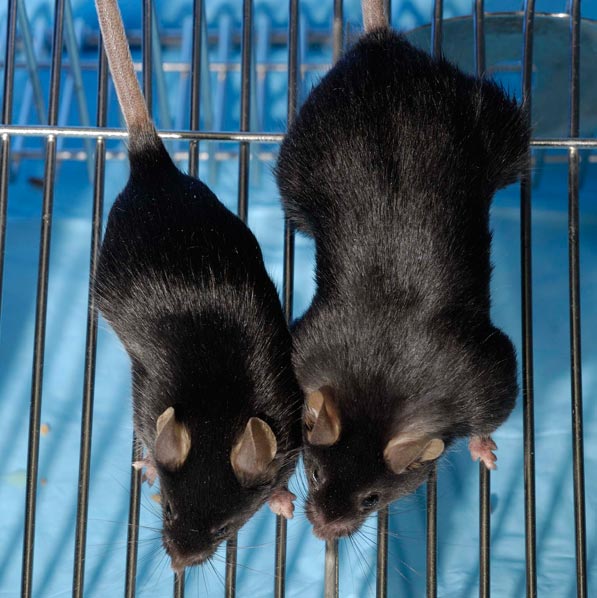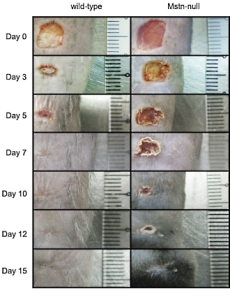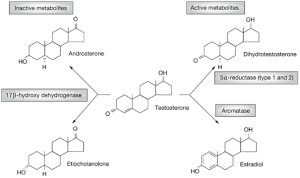Myostatin is a protein primarily produced in the muscles cells which inhibits the muscle growth process. As a result, a lot of research has been done central to myostatin’s role in the body in hopes of discovering a potential avenue for treating muscular dystrophy. Many athletes, once they learn about this protein, quickly seek ways to stifle it or its inhibitive properties. Capitalizing on that demand, supplement companies have eagerly begun marketing “myostatin inhibitor” products. Luckily for many of the athletes quick to jump the gun, all of those supplements have been proven benign at best, and are an absolute waste of money. There are many risks associated with inhibiting myostatin that were not as viral on the web as the muscle enhancing effects. Granted, until studies are warranted on humans, it is unclear how myostatin inhibition would affect humans (remember clenbuterol in bulls vs humans), or what the proper dosing protocol would be to mitigate the harmful effects.
That said, it is first important to discuss why this mechanism may have evolved:
If you think of your body as an economy, skeletal muscle is the luxury that you can only afford when you have enough resources (think money) to cover your basic needs. Imagine you are a fisherman, and can only work 8 months out of the 12 in a year. If you are a wise fisherman, you adapt and put money away in savings in preparation for the 4 months you will be without a steady stream of income. If you are a rookie fisherman, you use your excess income to fund your Ferrari payment, neglecting saving for the 4 months you will be without income. When fishing season is over, our experienced and well-adept fisherman can comfortably see himself through the 4 months, covering his basic needs, whereas our rookie fisherman will find himself starving to death, and his Ferrari repossessed as a result of missed payments.
Remember that primitive man did not have the ability to store or access food with the same ease that we do today. Instead, we had to evolve a self-contained storage-system: Fat. Fat is the equivalent of our wise fisherman’s savings account. Sacrificing a bit of luxurious muscle tissue for fat tissue from excess calories made survival much more likely. Ancestral men whose resources were devoted to building luxurious muscle, did not have the fat savings that prepared them for times when resources were scarce, and did not survive to pass on that genetic disadvantage, much like our rookie fisherman.
Of course in this day in age with constant access to food, this mechanism may seem vestigial, and almost like a bit of a nuisance. But as science has proven before, things in the human body are not so black and white, and myostatin’s sole function is not simply to inhibit the sweet gains of the muscle-conscious. Diving into the research, we have discovered quite a bit more about myostatin’s role in mammalian bodies.
Seen these little guys before? The subject on the right was the reason myostatin inhibition got so much attention.

Source: The Technology Review
The mouse on the right’s ability to create myostatin was removed via gene-therapy. As a result, he was able to produce muscle tissue to the tune of roughly ~30% more mass than his wild-type counterpart. In addition to skeletal muscle mass, the mouse proportionately grew cardiac mass, and the ratio was no different to what scientists would expect to find in the mice’s wild counterparts. It seemed like the holy grail of performance enhancing drugs had been found. The study showed that in addition to the mass, grip strength significantly increased, and necessary resting time significantly decreased. This was a way to enhance muscle mass and strength without disrupting the endocrine system, and the mice seemed perfectly healthy lived seemingly normal lives. However digging deeper into the biology of the mouse told a different story. In addition, other studies have been conducted with new and different findings.
That same study also pointed out a critical flaw in the structural integrity of the muscle quality: “myostatin inhibitors have not shown any improvement on eccentric contraction-induced force drop, a key measure of myofiber structural integrity”. This finding begged the question of whether or not this was a viable treatment option for muscular dystrophy. Normally, humans can put down more weight than they can lift, a trait arguably evolved for our own safety. What this suggested for example is that, when curling, a person could lift more weight up (concentric), than that same person could lower down (eccentric) safely. It’s cringeworthy to think of a gym where average gym goers could lift more than they can safely put down.
Another study points out the drastic reduction in stamina. Mice that were unable to produce myostatin and their “normal” counterparts were placed on the same diet and exercise routine. For four weeks, the mice ran thirty-minutes a day, five times a week. Though the myostatin-absent mice did indeed grow more muscle, they lost out in terms of stamina quite significantly. The genetically altered mice ran 28% less long, covered 40% less meters and had 38% less endurance capacity than than the natural mice. Despite this, the study did also show that the mice are indeed capable of responding normally to endurance training albeit not as efficiently.
Another study discovered that myostatin receptors exist in tendons. The scientsits compared the tendon elasticity of wild type mice, and myostatin-free mice and concluded that myostatin inhibition leads to significantly more brittle and stiff tendons. As most athletes require explosive and rapid movements, the benefits of size and strength may not outweigh the greatly increased risk of injury.
Lastly, A study conducted in Singapore aimed to discover how myostatin might play a role in the healing process. The scientists inflicted wounds on two types of mice: normal mice, and myostatin-less mice and logged healing progress over the course of about two weeks. Seen below, it became evident that myostatin-less mice healed significantly slower:

As it turns out, myostatin plays a role in healing at the dermis (skin) level and “without myostatin, new cells are produced more slowly in the dermis layer, and the cells also produce less collagen”.
At first glance, myostatin appeared to be the holy grail for athletes seeking strength, speed and size. However given recent advances in our knowledge of myostatin’s role in the body, it becomes evident that the benefits do not come without a cost: significantly less endurance, weaker and more brittle tendons, strength imbalances between eccentric and concentric movements, and a poorer affinity to heal wounds. It seems that performance athletes might want to give myostatin inhibition a second thought. Physique athletes and bodybuilders more concerned with appearance than performance, however, may welcome introducing myostatin inhibition supplementation into their regimen. Other drugs such as HGH and IGF-1 proven to increase collagen synthesis and wound healing may be a solution in combatting some of the negatives associated with myostatin inhibition.



